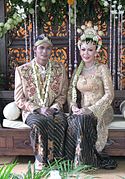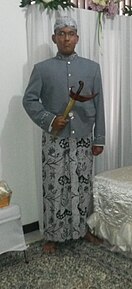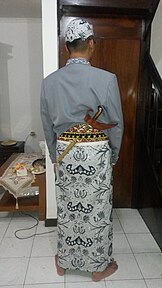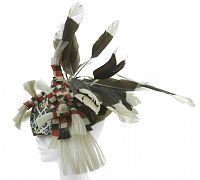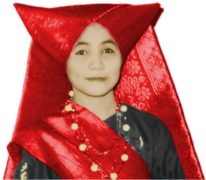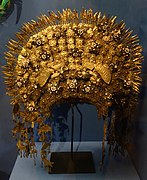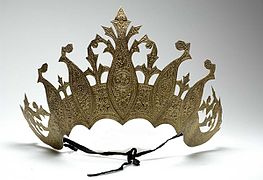National costume of Indonesia
The national costume of Indonesia (
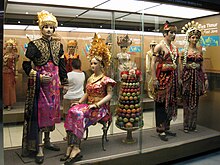
As a multi-diverse country, Indonesia having more than 30 provinces, each has its own representation of traditional attire and dress from each province with its own unique and distinguished designs.
National attires are worn during official occasions as well as traditional ceremonies. The most obvious display of Indonesian national attires can be seen by the type of attires worn by the President of Indonesia and the Indonesian first lady in many and different types of occasions and settings, and also worn by Indonesian diplomatic officials during gala dinners. Traditional weddings and formal ceremonies in Indonesia are important occasions in the country where the wear of Indonesia national attires are absolutely visible ranging from traditional to modern attires different from each region they are representing.
National attires
Batik
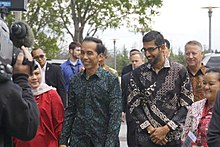
Batik is a cloth that is traditionally made using a manual wax-resist dyeing technique to form intricate patterns. Traditionally batik cloth is a large piece of intricately decorated cloth used by Javanese women as kemben or torso wrap. Batik cloth were wrapped around the hips with multiple folds in front called wiron, while the upper torso wear kebaya fitted dress. Traditionally for men, the edge of batik cloth also can be sewn together to make a tubular cloth as sarong, or wrapped around hips as kain in fashion similar to women's. Later for men, the batik cloth also sewn and made into contemporary batik men's shirt.
Batik is recognized as one of the important identity of
Batik shirts, which are commonly worn by men in Indonesia (especially in Java), are usually worn during formal occasions; such as attending weddings, traditional ceremonies, formal meetings, communal gatherings, etc. Sometimes men who wear batik shirt usually also wearing a songkok or peci cap to make it more formal in a traditional way. Batik shirts have two types of cuts: long sleeves for formal occasions, and short sleeves for casual to semi-formal occasions. Batik shirt or blouse are also available for women. Batik pattern differs from region to region, especially across Java and other islands, and have their own motifs or patterns unique to respective local tradition and culture.
Kebaya

The
The earliest form of kebaya originates in the court of the Javanese Majapahit Kingdom as a means to blend the existing female Kemban, torso wrap of the aristocratic women to be more modest and acceptable to the newly adopted Islam religion. Aceh, Riau and Johor kingdoms and Northern Sumatra adopted the Javanese style kebaya as a means of social expression of status with the more alus or refined Javanese overlords.[4]
Kebaya is usually worn during official national events by the Indonesian first lady, wives of Indonesian diplomats, and Indonesian women in general. It also worn by Indonesian women attending traditional ceremonies and weddings. In Kartini day on 21 April Indonesian women usually wear kebaya to celebrate and honor the Indonesian women emancipation heroine. During Balinese traditional ceremonies, Balinese women wore colorful Balinese style kebaya with songket Bali.
Peci
The
Since then, the black velvet peci is approved to be the national head-dress for Indonesian men. It is worn all over Indonesia, especially by government officials and men (usually
Regional attires
Other than the national attires, each of the
-
Malay Riau Islands
-
Batak Karo
Textiles

Stamped batik, the design of which takes months to create; double weave ikat from the islands of Nusa Tenggara, silk Bugis sarong from Sulawesi, gold-painted Balinese prada fabric; shimmering kain songket from Palembang utilizing silver and gold metallic threads weft in woven cotton or silk ikat; and tapis weavings from Lampung. Weavings from the 34 provinces utilize different materials, methods, colors and designs. Primarily formed on back looms, weeks or months are spent creating intricate designs for everyday use or ceremonial wear. These weavings are primarily known by the different techniques that are used to create the distinctive designs.
The symbolism of the various ethnic groups is evident in the variety of textiles. Color, shapes and their arrangements all have special meanings. Certain designs can only be worn by women or men, or only by the members of the royal family or nobility. Special textiles are worn or exchanged in life cycle or rights of passage ceremonies celebrating birth, circumcision, puberty, marriage, childbearing and death. Textiles play an important role in many traditional events and ceremonies.
Written records dating to the fourteenth century document the importance of textiles in the social and religious lives of Indonesians. The highly distinctive traditional dress, or pakaian adat, best shows the diversity of uses of textiles throughout the archipelago. The even more elaborate bridal dress displays the best of each province's textile and ornamental jewelry traditions.
- Sarong is the most popular waist worn garment in Indonesia mainly worn by men. It is popular among Muslim men across Indonesia and also by other regions and tribes throughout the country. It is mainly worn in Java, Bali, Sumatra, Kalimantan, and other places. It is very similar to the Indian Lungi.
- Torajatribes.
- Batak tribes of North Sumatra, usually slung over the shoulderduring traditional occasions.
- Tapis, a traditionally hand-woven fabric, specific to Lampung province on the southern part of Sumatra.
- Tenun, is a generic Indonesian term for "woven". It encompasses a wide array of Indonesian traditional hand woven textiles.
Clothing
In the Indonesian archipelago, the most basic and traditional way to wear a traditional garments, is just by wrapping the traditional fabrics around the hips as kain or sarong and secure it; and for women, wrapping the torso with kemben (torso wrap). This practice can still be found in Java, Bali, and Nusa Tenggara. Nevertheless, the development and the expansion of sewing and clothing techniques has creates tailored shirts for men and women. Tight fitting women's kebaya and tailored batik shirt for men is the example of traditional clothing that today transcends ethnic boundaries in Indonesia and has become a national attire. Other than those two, there are a number of tailored shirts or clothing developed in Indonesia.
Men
- Baju koko also known as baju takwa, a traditional Indonesian men peci.
- Beskap, Javanese traditional clothing worn usually by men for formal traditional attire
Women
- Kemben, is a classic Javanese female torso wrap historically common in Java and Bali, commonly uses batik cloth.
- Malay women's blouse.
- .
- Daster is a women's informal home-dress made of thin fabric and is a full body dress. It usually has the motives of batik patterns and is widely worn by women inside the home in Indonesia.
Headgear
Each different region, island, tribe, and culture in Indonesia has its own head-dress/head-gear worn traditionally by the particular people of the area. The
Men
-
A boy wearing the Balinese udeng
-
A Javanese Yogyakartan blangkon
-
An Acehnese kupiah meukeutob
-
A Bugis-style songkok from Bima
-
A Dayak feathered hat beluko
-
AMalaytanjak
- Blangkon, Javanese men's headgear
- Iket , Sundanese men's headgear
- Kupiah, Acehnese men's headgear
- Malaymen's headgear
- Udeng, Balinese men's headgear
- Beluko, Dayak feathered hat; there are different versions for men and women
- Songkok Recca, Buginese men's headgear
- Passapu, Makassarese men's headgear
Women
-
A woman wears a Minang tengkuluk tanduk horned head-dress.
-
Cunduk mentul or kembang goyang hair ornament
-
A traditional Indonesian women's head-dress; jamang or siger crown and kembang goyang
-
A Minang suntiang, gilded crown for bride
-
A Palembang-style siger, singkar sukun pa sangko, gilded crown for bride or dancer
-
A traditional Lampung siger headgear
- Konde or sanggul, originally referred to a type of hairdo. Today, it refers to a hairbun extension, attached to the back of the head. Commonly worn by women in Java and Bali as a part of their kain kebaya attire. The hairbuns are usually made from natural human hair. Konde is usually secured with a tusuk konde hairpin, and adorned with a jasmine flower garland or other hair ornaments.
- Kembang goyang (lit.: "trembling flower") or cunduk mentul, a golden flower ornament attached to the hairbun. Similar metallic floral hair ornaments can be found throughout Indonesia, however it is more prevalent in Java and Bali.
- Jamang, a gilded tiara-like crown, worn around the forehead to the side of the head. It was derived from Hindu-Buddhist heritage, now still worn in Javanese and Balinese wayang orang performance, Javanese srimpidancers, and Sundanese bride headgear.
- Siger, a large horned and gilded Lampung women's headgear. Today, usually made of brass. In Palembang, a smaller similar version is known as singkar.
- Suntiang, a tall, large and rather heavy Minang gilded crown for the bride. Traditionally made from gold, today however, usually made from brass.
- Tengkuluk tanduk, a horned head-dress made from folded traditional fabrics (usually songket), unique to Minang culture, especially Bundo Kanduang attire.
- Kerudung, a traditional Muslim women's veil of loosely worn cloth over the head. Unlike completely covered jilbab, parts of hairs and neck are still visible.
- Jilbab, a more conservative generic Muslim women's veil, adopted from Middle Eastern style. Usually worn by more conservative Muslim women. Unlike kerudung, hair and neck are completely covered.
See also
- Culture of Indonesia
- Etiquette in Indonesia
- Indonesian cuisine
- Native Indonesian
- Rumah adat
References
- ^ Xia Ziyi (2011-11-16). "Cultural feast at ASEAN Fair". Xinhua. Archived from the original on 19 December 2011. Retrieved 28 March 2012.
- ^ ISBN 0313333394. 237 pages
- ^ Indonesian Batik Inscribed in 2009 on the Representative List of the Intangible Cultural Heritage of Humanity
- ^ Maenmas Chavalit, Maneepin Phromsuthirak: Costumes in ASEAN: ASEAN Committee on Culture and Information: 2000:
ISBN 974-7102-83-8. 293 pages
- ^ Yusep Hendarsyah (28 April 2011). "Peci Hitam dan Identitas Paling Indonesia". Kompasiana. Archived from the original on 12 August 2012. Retrieved 28 March 2012.
- ^ "Tenun Songket Pandai Sikek (Sumatera Barat - Indonesia)". Archived from the original on 2016-04-23. Retrieved 2016-04-06.
- ^ Kartika Suardana. "Songket Bali, Busana dan Aksesori Nusantara". National Geographic Traveller Indonesia (in Indonesian) (Vol 1, No 6, 2009 ed.). Jakarta, Indonesia. p. 62.
- ^ Manggalani L Ukirsari. "Songket Lombok, Busana dan Aksesori Nusantara". National Geographic Traveller Indonesia (in Indonesian) (Vol 1, No 6, 2009 ed.). Jakarta, Indonesia. p. 62.

